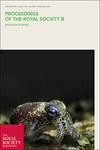塞浦路斯的少量旧石器时代人类捕杀地方性巨型动物,导致其灭绝。
IF 3.8
1区 生物学
Q1 BIOLOGY
Proceedings of the Royal Society B: Biological Sciences
Pub Date : 2024-09-18
DOI:10.1098/rspb.2024.0967
引用次数: 0
摘要
第四纪晚期巨型动物灭绝的假定主要驱动因素在人类过度开发和环境变化之间摇摆不定,最近的研究表明,这些驱动因素之间更微妙的协同作用取决于分类群、空间尺度和区域。然而,大多数研究仍然依赖于比较基于考古学的人类最初进入原始生态系统的时间和古生物学推断的巨型动物灭绝时间。通过比较年代学得出的结论还取决于年代证据的可靠性、年代的不确定性以及对低保存概率(Signor-Lipps效应)的校正。虽然已经建立了一些模型来测试巨型动物对理论捕食率的易感性,但还没有一个模型明确地将人类的能量需求、猎物选择和狩猎效率联系起来,以研究人类驱动灭绝的合理性。将更新世末期的塞浦路斯岛作为理想的测试案例,是因为该岛的人类定居时间较晚(约 14.2-13.2 ka)、面积小(约 11 000 平方公里)和巨型动物多样性低(2 种),我们建立了巨型动物种群动态的随机模型,由人类的能量需求、猎物选择和狩猎效率函数决定摄取量,以检验更新世末期的人类种群是否可能导致矮河马(Phanourios minor)和矮象(Palaeoloxodon cypriotes)的灭绝。我们的模型不仅揭示了在晚更新世塞浦路斯估计的人类种群数量(n = 3000-7000)可以很容易地导致这两个物种在小于 1000 年的时间内灭绝,而且模型的预测结果与观察到的、从古生物记录中推断出的经 Signor-Lipps 校正的巨型动物灭绝时间顺序(P. minor 在约 12-11.1 ka,其次是 P. cypriotes 在约 10.3-9.1 ka)相吻合。本文章由计算机程序翻译,如有差异,请以英文原文为准。
Small populations of Palaeolithic humans in Cyprus hunted endemic megafauna to extinction.
The hypothesized main drivers of megafauna extinctions in the late Quaternary have wavered between over-exploitation by humans and environmental change, with recent investigations demonstrating more nuanced synergies between these drivers depending on taxon, spatial scale, and region. However, most studies still rely on comparing archaeologically based chronologies of timing of initial human arrival into naïve ecosystems and palaeontologically inferred dates of megafauna extinctions. Conclusions arising from comparing chronologies also depend on the reliability of dated evidence, dating uncertainties, and correcting for the low probability of preservation (Signor-Lipps effect). While some models have been developed to test the susceptibility of megafauna to theoretical offtake rates, none has explicitly linked human energetic needs, prey choice, and hunting efficiency to examine the plausibility of human-driven extinctions. Using the island of Cyprus in the terminal Pleistocene as an ideal test case because of its late human settlement (~14.2-13.2 ka), small area (~11 000 km2), and low megafauna diversity (2 species), we developed stochastic models of megafauna population dynamics, with offtake dictated by human energetic requirements, prey choice, and hunting-efficiency functions to test whether the human population at the end of the Pleistocene could have caused the extinction of dwarf hippopotamus (Phanourios minor) and dwarf elephants (Palaeoloxodon cypriotes). Our models reveal not only that the estimated human population sizes (n = 3000-7000) in Late Pleistocene Cyprus could have easily driven both species to extinction within < 1000 years, the model predictions match the observed, Signor-Lipps-corrected chronological sequence of megafauna extinctions inferred from the palaeontological record (P. minor at ~12-11.1 ka, followed by P. cypriotes at ~10.3-9.1 ka).
求助全文
通过发布文献求助,成功后即可免费获取论文全文。
去求助
来源期刊
CiteScore
7.90
自引率
4.30%
发文量
502
审稿时长
1 months
期刊介绍:
Proceedings B is the Royal Society’s flagship biological research journal, accepting original articles and reviews of outstanding scientific importance and broad general interest. The main criteria for acceptance are that a study is novel, and has general significance to biologists. Articles published cover a wide range of areas within the biological sciences, many have relevance to organisms and the environments in which they live. The scope includes, but is not limited to, ecology, evolution, behavior, health and disease epidemiology, neuroscience and cognition, behavioral genetics, development, biomechanics, paleontology, comparative biology, molecular ecology and evolution, and global change biology.

 求助内容:
求助内容: 应助结果提醒方式:
应助结果提醒方式:


